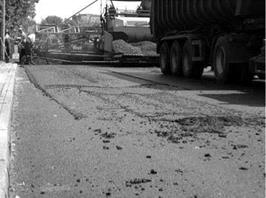Unevenness or irregularities
The last problem encountered when spreading SMA (and other asphalt mixtures, too) is unevenness caused by the approach of a paver on mixture residue left over on a bottom layer. Figure 11.33. shows how such residue builds up.
Different type of scrapers, sweepers, and other similar inventions fixed to the paver cannot fully protect it from causing unevenness. The care of cleanliness of the bottom layer is the responsibility of the paving crew. It consists not only in the skillful handling of a shovel but the proper coordination of mixture delivery from the dump truck into the paver hopper.
The material that is dumped in front of the paver also can cool before compaction, causing an internal porous area that can later trap water and then disintegrate the SMA layer.
Although thermal problems appear on almost every construction site and apply to any type of mixture, they seem to be underestimated. Examples of pavement damage presented in the previous pages, which developed during the construction stages, should make us aware of their power to reduce a new pavement’s durability.
The use of infrared cameras has its strengths because it enables the spotting of potentially weak areas during construction when corrective measures can still be
|
FIGURE 11.33 Remains of mixture left on a bottom layer resulting in unevenness of the finished course. (Photo courtesy of Krzysztof BlaZejowski.) |
taken. Finally, it is worth finding the causes of damaged pavements that have potholes, bumps, and cracks appearing in the most unexpected places. Maybe it is time to view thermal differences as a potential cause of these defects.







Leave a reply